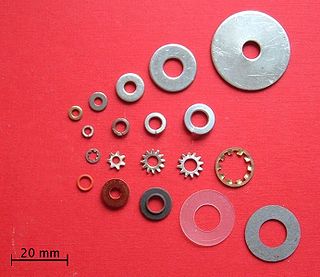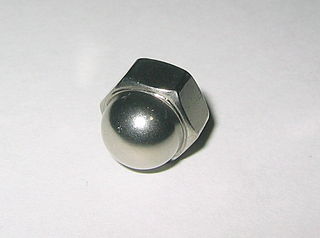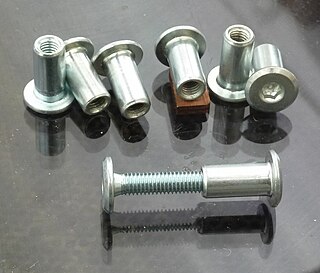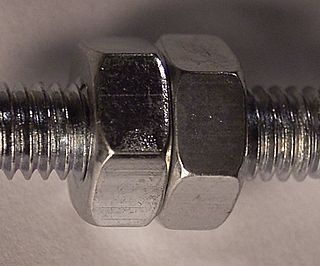Related Research Articles

A washer is a thin plate with a hole that is normally used to distribute the load of a threaded fastener, such as a bolt or nut. Other uses are as a spacer, spring, wear pad, preload indicating device, locking device, and to reduce vibration.

A bolted joint is one of the most common elements in construction and machine design. It consists of a male threaded fastener that captures and joins other parts, secured with a matching female screw thread. There are two main types of bolted joint designs: tension joints and shear joints.

An acorn nut, also referred to as crown hex nut, blind nut, cap nut, domed cap nut, or dome nut (UK), is a nut that has a domed end on one side. When used together with a threaded fastener with an external male thread, the domed end encloses the external thread, either to protect the thread or to protect nearby objects from contact with the thread. In addition, the dome gives a more finished appearance.

A sex bolt is a type of fastener comprising a mated pair of screw and post, which are a machine screw and a nut that is barrel-shaped. The nut has a flange and a protruding boss that is internally threaded. The bolt sits within the components being fastened, and the flange provides the bearing surface.

A locknut, also known as a lock nut, locking nut, self-locking nut, prevailing torque nut, stiff nut or elastic stop nut, is a nut that resists loosening under vibrations and torque. Prevailing torque nuts have some portion of the nut that deforms elastically to provide a locking action. Free-spinning locknuts exist which carry the advantage of not requiring extra torque until seated.

A nyloc nut, also referred to as a nylon-insert lock nut, polymer-insert lock nut, or elastic stop nut, is a kind of locknut with a nylon collar that increases friction on the screw thread.

A jam nut is a low profile type of nut, typically half as tall as a standard nut. It is commonly used as a type of locknut, where it is "jammed" up against a standard nut to lock the two in place. It is also used in situations where a standard nut would not fit.

A flange nut is a nut that has a wide flange at one end that acts as an integrated washer. This serves to distribute the pressure of the nut over the part being secured, reducing the chance of damage to the part and making it less likely to loosen as a result of an uneven fastening surface. These nuts are mostly hexagonal in shape and are made up of hardened steel and often coated with zinc.
A split beam nut, also known as a split hex nut or slotted beam nut, is a locknut with slots cut in the top that separate the outside end into two or more sections that are bent slightly inward, making the thread diameter undersized in the slotted portion. As the nut is threaded on, these sections are forced back out to their original position and increase the friction between the nut and the fastener, creating the locking action.

A rivet nut, also known as a blind rivet nut, or rivnut, is a one-piece internally threaded and counterbored tubular rivet that can be anchored entirely from one side. It is a kind of threaded insert. There are two types: one is designed to form a bulge on the back side of the panel as a screw is tightened in its threads. The other is similarly drawn in using a screw, but is drawn into the sleeve instead of creating a bulge.

A speed nut, aka sheet metal nut or Tinnerman nut, is a type of locknut with two sheet metal prongs that act as one thread. They are made from spring steel.

A weld nut is a special type of nut specifically designed to be welded to another object. There are various types for different applications.
A jet nut, also known as a k-nut, is a special type of hex locknut that is commonly used in the aerospace and automotive racing industries.
An interfering thread nut is a type of locknut that has an undersized root diameter. This creates an interference between the nut and the fastener, plastically deforming the threads on the fastener. Due to this deformation they are usually only used on permanent or semi-permanent installations.
A plate nut, also known as a nut plate, anchor nut or anchor plate, is a stamped sheet metal nut that is usually riveted to a workpiece. They have a long tube that is internally threaded and a plate with two clearance holes for rivets. The most popular versions have two lugs and they exist as fixed anchor nuts and as floating anchor nuts. The latter allows the nut to move slightly and so enlarges the positioning tolerances of the mounted parts. They were originally developed for the aerospace industry but are now also common in automotive racing.
A clip-on nut, also known as a sheet metal nut or a speed nut, is a type of nut designed to be clipped to sheet metal. It is a type of captive nut commonly made as a cage nut.

A nut is a type of fastener with a threaded hole. Nuts are almost always used in conjunction with a mating bolt to fasten multiple parts together. The two partners are kept together by a combination of their threads' friction, a slight stretching of the bolt, and compression of the parts to be held together.

A bolt is an externally helical threaded fastener capable of being tightened or released by a twisting force (torque) to a matching nut. The bolt has an external male thread requiring a matching nut with a pre-formed female thread.
Philidas Ltd. is a company based in Pontefract, West Yorkshire, England that manufactures nuts and components for automotive and industrial applications.

A security locknut is a type of industrial fastener composed of two steel threaded parts: a nut body and an elliptical spring steel lock ring. Security locknuts are fastened onto a mating bolt to form a bolted joint. Forces of friction, a stretching of the bolt, and compression hold the bolted joint firmly together. The lock ring, once assembled into a counterbore in the nut body, provides clamping force on the bolt while the nut body takes the load. This isolates the loading and locking functions and helps prevent the nut from backing off the bolt. Due to the durable spring steel alloy, the security locknut is fully reusable while maintaining prevailing torque in each application.
References
Notes
- 1 2 3 4 McMaster, p. 3139.
- 1 2 Smith, pp. 104–105.
- ↑ Non-slotted hex locknut, archived from the original on 2011-05-13, retrieved 2008-11-30.
- ↑ Philidas nut, archived from the original on 2015-03-07, retrieved 2012-12-01.
Bibliography
- McMaster-Carr catalog (114th ed.), McMaster-Carr.
- Smith, Carroll (1990), Carroll Smith's Nuts, Bolts, Fasteners, and Plumbing Handbook, MotorBooks/MBI Publishing Company, ISBN 0-87938-406-9 .